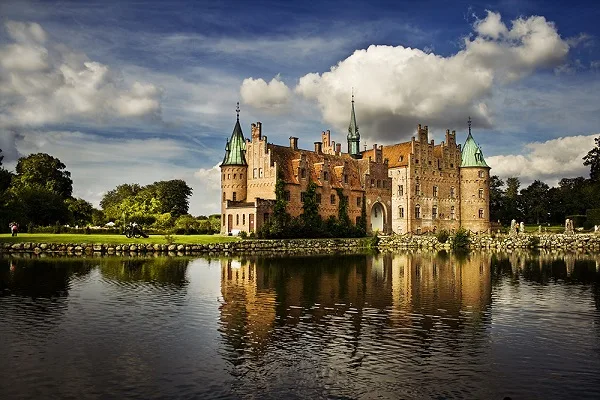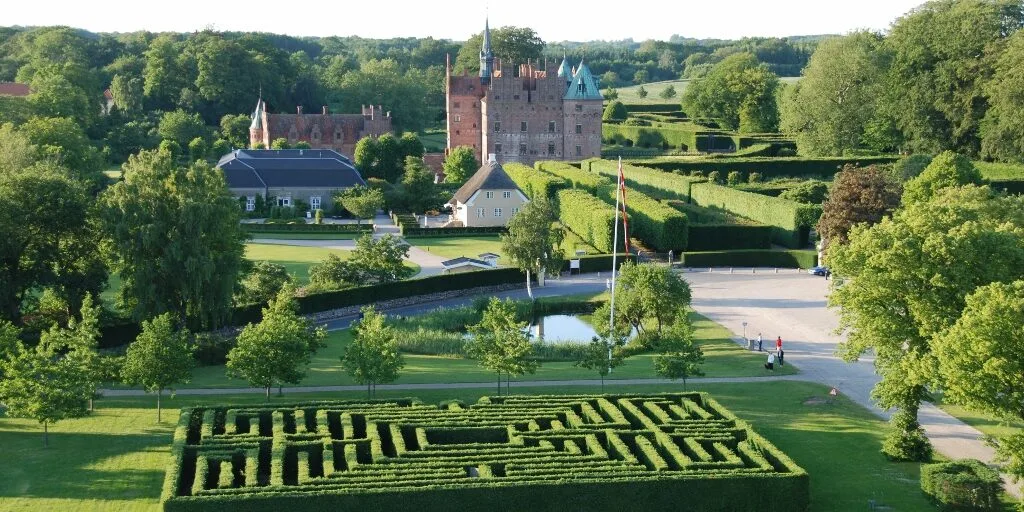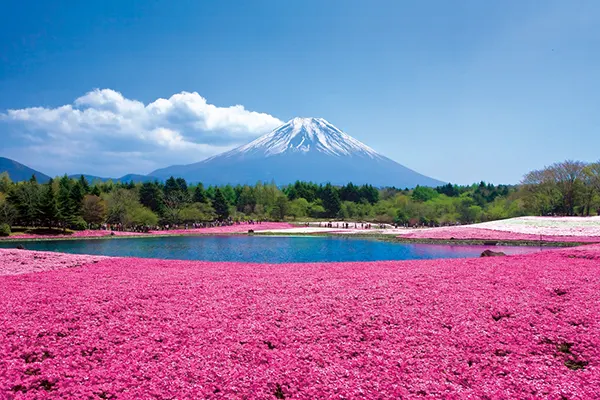
Exploring Egeskov Castle: A Jewel of Danish Heritage
Denmark is home to many historical landmarks, but Egeskov Castle stands out as a must-visit destination for anyone interested in history, architecture, and beautiful gardens. This article takes you through the rich history of Egeskov Castle, its resilient past, the attractions that make it a popular tourist spot, and its significance in Danish heritage.
When Was It Built and Where
Egeskov Castle, located on the island of Funen in Denmark, is an exemplary model of Renaissance architecture. Constructed in 1554 by Frands Brockenhuus, the castle is renowned for its beauty and the intricacy of its design. Situated amidst a lake, it provides a picturesque reflection of a bygone era, surrounded by extensive gardens that add to its allure.
The castle’s location was strategically chosen for defense, with its foundation laid on oak piles driven into the lake bed, giving rise to its name, Egeskov, meaning “oak forest.” Over the centuries, Egeskov Castle has been preserved meticulously, allowing visitors to step back in time and experience the Renaissance period first-hand.
The Story of Who Ruled This Castle
Since its construction, Egeskov Castle has been home to numerous noble families, starting with the Brockenhuus family. The castle’s history is a tapestry of alliances and inheritances that reflect the changing dynamics of Danish nobility.
In the 18th century, the castle came under the ownership of the Bille family, followed by the Ahlefeldt family, who are the current occupants. Each family that has resided at Egeskov has left its mark, contributing to the castle’s expansion and the cultivation of its famed gardens.
The lineage of rulers has not only maintained the castle’s structure but also its significance in Danish cultural and historical heritage, making it a living museum of Denmark’s noble past.
How Many Sieges He Withstood
Egeskov Castle’s strategic location and robust construction meant it was built to withstand sieges. Throughout its history, it has been a symbol of resilience, though records of specific sieges are more myth than documented history. The castle’s design, with thick walls, a moat, and a drawbridge, was intended for defense, reflecting the turbulent times of the 16th century.
The castle’s architecture includes features such as shooting ports and a complex layout designed to confuse and slow down invaders. These defensive measures ensured that Egeskov could stand firm against potential sieges, securing its occupants and their treasures.
Despite the lack of recorded sieges, the castle’s ability to remain intact through centuries of political and social upheaval speaks volumes about its resilience and strategic importance in Danish history.

Attractions
Egeskov Castle is not just a historical monument; it is a cultural treasure trove with a variety of attractions. The castle houses museum collections that include vintage cars, motorcycles, and even a Falck museum, showcasing the history of Denmark’s emergency rescue service.
The gardens of Egeskov are a masterpiece of landscaping, offering a blend of traditional and modern garden designs. The maze, the Renaissance garden, and the seasonal flowers make it a paradise for nature lovers. The castle also hosts events, concerts, and exhibitions, making it a vibrant cultural hub throughout the year.
How Popular This Place Is
Egeskov Castle is one of Denmark’s most visited tourist attractions, drawing visitors from all over the world. Its popularity stems from its rich history, architectural beauty, and the wide range of activities it offers. The castle is not only a testament to Denmark’s past but also a beacon of preservation, showing how historical sites can be kept alive and relevant in the modern world.
The castle’s ability to blend historical education with entertainment makes it a unique destination. From walking through the historic halls to enjoying the tranquility of its gardens, Egeskov Castle offers an enriching experience that captivates the imagination of all who visit.
Popular articles
-
 Hokkaido, Japan: Northern Landscapes, Hot Springs and World-Class Cuisine
Hokkaido, Japan: Northern Landscapes, Hot Springs and World-Class CuisineHokkaido, the northernmost island of Japan, is a region that …
-
 Kyoto: Japanese Minimalism, Tea Ceremonies, and Zen Gardens
Kyoto: Japanese Minimalism, Tea Ceremonies, and Zen GardensKyoto stands apart as Japan’s heart of tradition. Far from …
-
 Timeless Cities: Why You Should Visit Mtskheta, Georgia
Timeless Cities: Why You Should Visit Mtskheta, GeorgiaMtskheta, one of the oldest cities in Georgia, is more …
